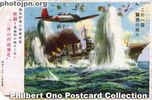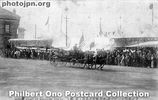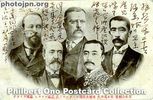 Last comments - Japan-America Relations Postcards Last comments - Japan-America Relations Postcards |

Wartime Mitsui Life Insurance ad card. Dated Feb. 1942, this advertising postcard shows a Japanese torpedo bomber dropping a torpedo aimed at a US battleship under heavy attack. An American flag (faint) can be seen on the ship's mast.Dated Feb. 1942, this advertising postcard shows a Japanese torpedo bomber dropping a torpedo aimed at a US battleship under heavy attack. An American flag (faint) can be seen on the ship's mast. The advertising copy reads, "This one shot is a phenomenal force." On the left, the text reads, "A new weapon for national savings." "Very low insurance premiums." "Mitsui's provision for old age" "It has no enemies!" For some reason, the left corners of the card were cut with scissors, perhaps to remove it from an album.
Needless to say, the lowest point in US-Japan relations was World War II. The Pearl Harbor attack, the internment of Japanese-Americans, battles at Midway and other Pacific islands, Tokyo fire bombing raids, land battle on Okinawa, and the nuclear bombing of Hiroshima and Nagasaki still reverberate among the generations today. Every year in August in Japan, ceremonies are held to mark and memorialize the Hiroshima and Nagasaki bombings and the war's end. All the while, Dec. 8 (7 in Hawaii) is just another day in Japan with no particular significance.
Of course in Hawaii, Dec. 7 is a day of national mourning as much as Hiroshima/Nagasaki Day in Japan. Each country mourns its own and neither seems to care about the other's war dead. I await the day when both countries mourn for each other as well as for themselves. After all, we all belong to the same family, the Family of Man.09/19/08 at 04:01kingston@greennet.net: From: kingston@greennet.net (Jul 15, 2005 11:53)...
|
|

Wartime Mitsui Life Insurance ad card. Dated Feb. 1942, this advertising postcard shows a Japanese torpedo bomber dropping a torpedo aimed at a US battleship under heavy attack. An American flag (faint) can be seen on the ship's mast.Dated Feb. 1942, this advertising postcard shows a Japanese torpedo bomber dropping a torpedo aimed at a US battleship under heavy attack. An American flag (faint) can be seen on the ship's mast. The advertising copy reads, "This one shot is a phenomenal force." On the left, the text reads, "A new weapon for national savings." "Very low insurance premiums." "Mitsui's provision for old age" "It has no enemies!" For some reason, the left corners of the card were cut with scissors, perhaps to remove it from an album.
Needless to say, the lowest point in US-Japan relations was World War II. The Pearl Harbor attack, the internment of Japanese-Americans, battles at Midway and other Pacific islands, Tokyo fire bombing raids, land battle on Okinawa, and the nuclear bombing of Hiroshima and Nagasaki still reverberate among the generations today. Every year in August in Japan, ceremonies are held to mark and memorialize the Hiroshima and Nagasaki bombings and the war's end. All the while, Dec. 8 (7 in Hawaii) is just another day in Japan with no particular significance.
Of course in Hawaii, Dec. 7 is a day of national mourning as much as Hiroshima/Nagasaki Day in Japan. Each country mourns its own and neither seems to care about the other's war dead. I await the day when both countries mourn for each other as well as for themselves. After all, we all belong to the same family, the Family of Man.09/19/08 at 04:00philbert: From: philbert@photojpn.org (May 13, 2004 14:19)...
|
|

Wartime Mitsui Life Insurance ad card. Dated Feb. 1942, this advertising postcard shows a Japanese torpedo bomber dropping a torpedo aimed at a US battleship under heavy attack. An American flag (faint) can be seen on the ship's mast.Dated Feb. 1942, this advertising postcard shows a Japanese torpedo bomber dropping a torpedo aimed at a US battleship under heavy attack. An American flag (faint) can be seen on the ship's mast. The advertising copy reads, "This one shot is a phenomenal force." On the left, the text reads, "A new weapon for national savings." "Very low insurance premiums." "Mitsui's provision for old age" "It has no enemies!" For some reason, the left corners of the card were cut with scissors, perhaps to remove it from an album.
Needless to say, the lowest point in US-Japan relations was World War II. The Pearl Harbor attack, the internment of Japanese-Americans, battles at Midway and other Pacific islands, Tokyo fire bombing raids, land battle on Okinawa, and the nuclear bombing of Hiroshima and Nagasaki still reverberate among the generations today. Every year in August in Japan, ceremonies are held to mark and memorialize the Hiroshima and Nagasaki bombings and the war's end. All the while, Dec. 8 (7 in Hawaii) is just another day in Japan with no particular significance.
Of course in Hawaii, Dec. 7 is a day of national mourning as much as Hiroshima/Nagasaki Day in Japan. Each country mourns its own and neither seems to care about the other's war dead. I await the day when both countries mourn for each other as well as for themselves. After all, we all belong to the same family, the Family of Man.09/19/08 at 03:59webmaster@postcard.org: From: webmaster@postcard.org (Jun 19, 2003 20:37...
|
|

Welcome Parade for the American Fleet. The fleet's crew enjoyed a few days in Japan and was given the red-carpet treatment. A welcoming parade was given in downtown Tokyo around Shimbashi (pictured above) and Hibiya Park.A large turnout is apparent in this photo showing a horse-drawn carriage carrying the US and Japanese flags.
American crewmen held Japanese paper umbrellas with a star design, while the Japanese and American flags were everywhere. Japan was highly in favor of peaceful relations with the U.S. The American sailors were surprised and delighted by the friendliness and hospitality of the Japanese.09/19/08 at 03:58Comments: From: Winston Hu (Jan 19, 2004 01:20)
It is a g...
|
|

Russo-Japan Peace Conference representatives. Left to right: Russian Finance Minister Count Sergei Witte, Baron Rosen, US President Theodore Roosevelt, Japanese Ambassador to the US Kogoro Takahira, and Japanese Foreign Minister Jutaro Komura.It was a time when nations jostled for territory and trade. The Russo-Japanese War of 1904-05 was waged mainly for the control of Manchuria and Korea. The US fully supported Japan and hoped that Japan would keep Korea open to all nations for commerce. The war started before it was declared with Japan launching a surprise attack to destroy part of the Russian fleet at Port Arthur in Manchuria and landing troops in Korea. The US and Great Britain cheered Japan. The US assumed that Japan would open up Asian markets. President Theodore Roosevelt believed that Japan was fighting Russia for America. But then, he also feared that if Japan won the war, there might be a struggle between the US and Japan in the future.
In the famous Battle of the Sea of Japan on May 27-28, 1905, Japan astonishingly defeated the Russian fleet which had sailed from the Baltic Sea eighteen months before. Even before this battle, Japan was financially drained and asked Roosevelt to mediate an end to the war. Although Japan was winning the war, they were outnumbered by the Russians who had the troops and resources to keep fighting. The Russian czar, however, finally relented after seeing his Baltic fleet destroyed.
A peace conference was held at Portsmouth, New Hampshire in July and Aug. 1905. The principle representatives are pictured in the postcard above. The caption on the bottom of the card identifies these men. The Japanese handwriting in-between is only correspondence and not part of the original postcard which has a postmark dated Aug. 30, 1905.
Harvard-educated Jutaro Komura was a star in Japan's Foreign Ministry and a successful diplomat in Washington DC and Peking. He was in favor of obtaining control in both Manchuria and Korea. Komura also was instrumental in having Japan form an alliance with Great Britain in 1902. This move further strengthened Japan's position vis-a-vis Russia. Anybody attacking Japan would also have to face the British who had the world's largest navy.
Count Sergei Witte created the Trans-Siberian railway and he was highly respected by the US.
For mediating peace between Japan and Russia, President Roosevelt went on to become the first American to win the Nobel Peace Prize in 1906.09/19/08 at 03:57Bengt: From: bengt.fagerholm@akseli.fi (Apr 07, 2004 03...
|
|

Drawing of Commodore Perry, Grossly distorted if not humorous rendition of Commodore Perry by a Japanese artist who apparently never knew what Perry really looked like. It was drawn at a time when the Japanese thought all foreigners were barbarians.09/19/08 at 03:56Comments: From: simpatico@sina.com (Nov 22, 2002 10:57)
t...
|
|

Commodore Perry Landing Monument. The Perry monument at Kurihama on the Miura Peninsula (Kanagawa Pref.) was built on July 14, 1901. It marks the spot where he first landed in Japan in 1853.Click to see what the monument looks like today. I wonder what happened to it during the World War II. Was it destroyed or left untouched? This postcard was made to commemorate the visit of the US Fleet in Oct. 1908.09/19/08 at 03:54Comments: From: Phil Conroy (Jun 16, 2003 03:49)
Yes, it ...
|
|
|
|
|